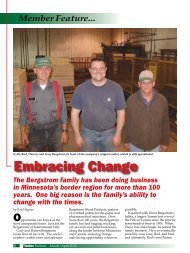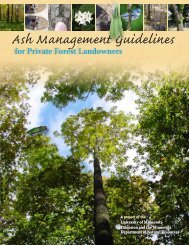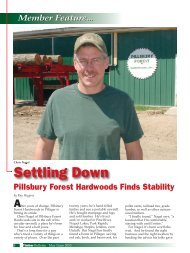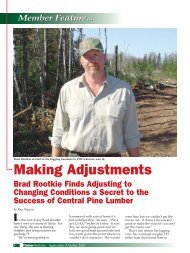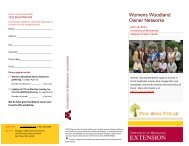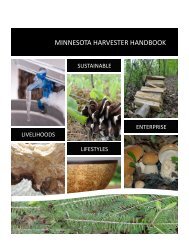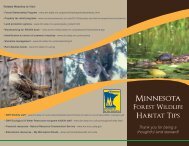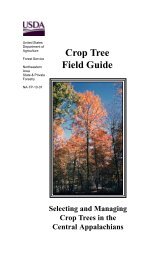Ash Management Guide for Private Forest Landowners
Ash Management Guide for Private Forest Landowners
Ash Management Guide for Private Forest Landowners
Create successful ePaper yourself
Turn your PDF publications into a flip-book with our unique Google optimized e-Paper software.
and re-colonize a burned landscape.<strong>Ash</strong> is poorly adapted to fire and thenutrient-poor soils of FD sites. However,fire-suppression ef<strong>for</strong>ts have opened FDsites to modest invasion by ash. About 20%of all FD <strong>for</strong>ests have ash regeneration,but just 3% have ash trees – meaning thatrecruitment is poor. When present, ashtrees account <strong>for</strong> about 8% of the trees onFD sites. Green ash is the most successfulspecies in FD <strong>for</strong>ests, with regeneration in15% of the sites. As a tree, it occurs in 3%of FD <strong>for</strong>ests and about 16% of the treesare ash when it is present. White and blackash occur in trace amounts on FD sites.Common trees:• Jack pine• Red pine• White pine• Quaking aspenShrubs:• American hazelnut• Poison ivy• Tall blackberry• Sand cherry• Wintergreen• Prairie willow• Wild rose• Juneberry• Grey dogwood• Snowberry• Pipsissewa• BearberryHerbaceous plants:• Common oak fern• Running clubmossChapter 5The Native PlantCommunitiesFire-dependentSystemSurvey Recommendations:Fire-dependent SystemThe effect of ash mortality due to EAB will be minimal in Fire-Dependent System.On quality sites continue to manage <strong>for</strong> quality ash. Gap phase dynamicswill dominate regeneration. In areas in close proximity to EAB do not assume anunlimited number of growing years <strong>for</strong> ash trees. Reduce the ashcomponent to less than 20%. <strong>Ash</strong> should be scattered throughout the standrather than having areas with high densities of ash. Prepare <strong>for</strong> replacement toinvasive species, <strong>for</strong> example buckthorn.Recommended replacement trees (as ranked by the experts):Northern Fire Dependent(10 out of 31 species)• Jack pine• White pine• Northern pin oak• Quaking aspen• Bur oak• Northern red oak• Paper birch• White oak• Big-toothed aspen• Red pineSouthern Fire Dependent(10 out of 31 species)• Northern red oak• Northern pin oak• Black oak• White oak• White pine• Bur oak• Shagbark hickory• Black cherry• Jack pine• Bigtoothed aspen51



